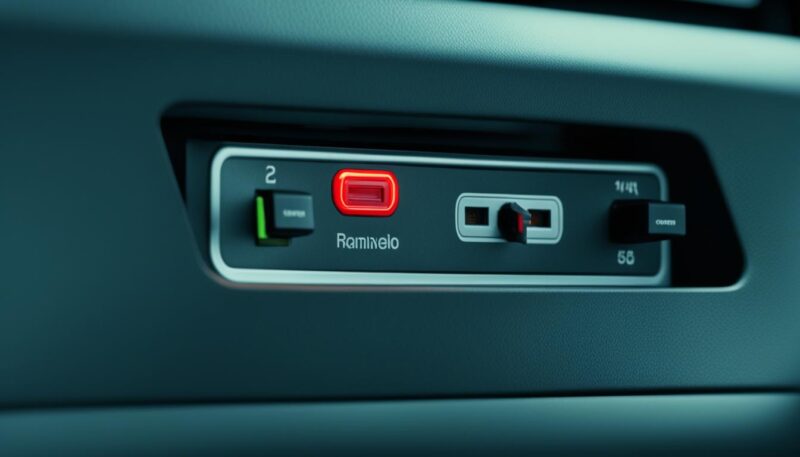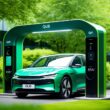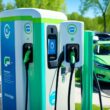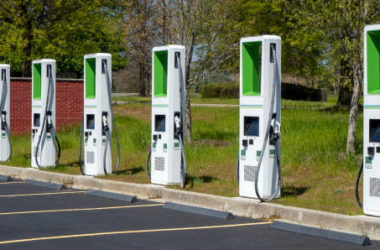Charging an electric vehicle (EV) requires the right equipment to ensure a safe and efficient charging process. One crucial component is the vehicle power electric socket leads, which connect the EV to the charging station or power source.
In this guide, I will provide detailed information about different types of vehicle power electric socket leads, as well as other essential components for electric car charging solutions. Whether you are a new EV owner or looking to upgrade your charging setup, this guide will help you make informed decisions.
From electric vehicle chargers to power outlet adapters, we will explore the various options for charging access for vehicles. We will also discuss automotive socket connectors, electric vehicle charging cables, and the power supply options available for EVs.
Key Takeaways:
- Choosing the right vehicle power electric socket leads is essential for safe and efficient EV charging.
- There are various options available, including electric vehicle chargers and power outlet adapters.
- Understanding automotive socket connectors and electric vehicle charging cables is crucial for a seamless charging experience.
- Consider the power supply options for your EV to ensure optimal charging performance.
- By following this guide, you can make informed decisions about your electric car charging solutions.
Understanding EV Charging Cables
EV charging cables are crucial components that facilitate the safe and efficient delivery of power from a power source to an electric car. These cables come in various types, each designed for specific charging requirements. Understanding the different types of EV charging cables can help electric vehicle owners choose the right option for their charging needs.
Types of EV Charging Cables
- Mode 1 charging cables: Mode 1 cables are primarily used for light electric vehicles and are considered less safe for use with electric cars. They are typically not recommended due to their limited safety features and slow charging capabilities.
- Mode 2 charging cables: Mode 2 cables are equipped with an In-Cable Control and Protection Device (IC-CPD) and allow for charging from a standard domestic socket. These cables provide a safer charging experience for electric car owners.
- Mode 3 charging cables: Mode 3 cables are currently the most common type of EV charging cables. They are designed for use with dedicated EV charging stations and offer faster and more efficient charging compared to Mode 2 cables.
- Mode 4 charging cables: Mode 4 cables are specifically designed for rapid charging and can handle higher power outputs. These cables are ideal for charging stations that offer fast charging capabilities.
Each type of EV charging cable serves a specific purpose in providing reliable and convenient charging options for electric vehicle owners. By selecting the appropriate cable type based on their charging needs, EV owners can ensure efficient and safe charging experiences.
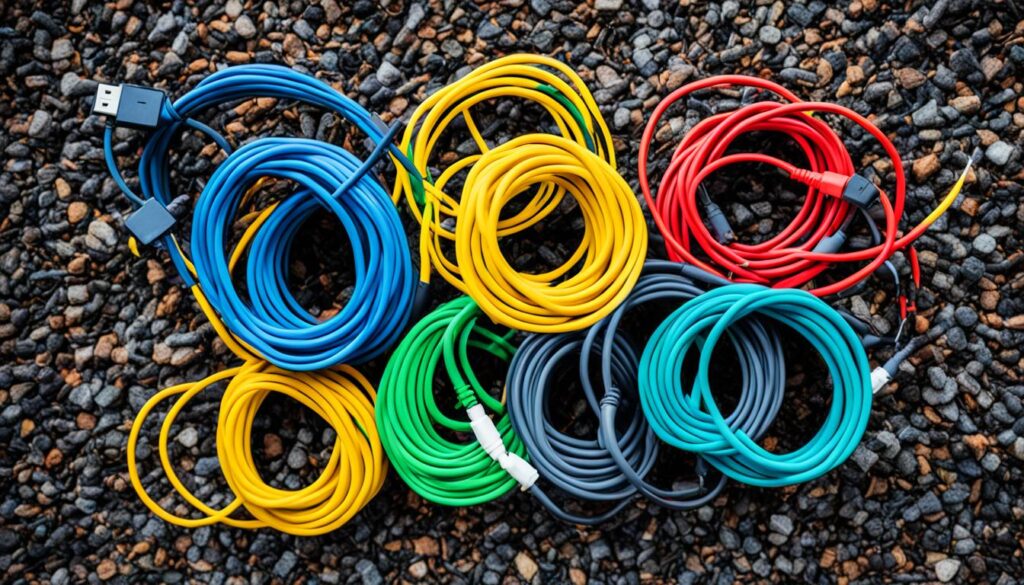
Exploring EV Charging Plugs
When it comes to EV charging, the type of plug used can vary depending on the manufacturer, country, and the specific charging requirements. In this section, we will delve into the different types of EV charging plugs and their applications. Let’s explore the world of EV charging plugs.
AC Charging Plugs
AC charging plugs are commonly used for electric vehicle charging. One type is the Type 1 plug, which is used in Japan and North America. It features a 5-pin connector and is suitable for standard AC charging. Another widely used AC charging plug is the Type 2 connector, which is prevalent in the UK, Europe, and the rest of the world. The Type 2 connector offers compatibility with AC charging stations and comes in different power ratings.
DC Rapid-Charging Plugs
For rapid charging, DC charging plugs are utilized. In North America, the CCS1 plug (Combo 1) is commonly used. It is a combination of the Type 1 connector and additional DC pins for rapid charging. In the UK and Europe, the CCS2 plug (Combo 2) is prevalent. Similar to the CCS1 plug, it combines AC and DC charging capabilities into a single plug. Japan predominantly uses the CHAdeMO plug, which is specifically designed for rapid charging. China utilizes the GB/T plug for high-power DC charging.
It is worth noting that Tesla vehicles use their own proprietary plug known as the North American Charging Standard (NACS). This plug is exclusive to Tesla vehicles in the US and enables rapid charging at Tesla Supercharger stations.
As the image suggests, there are various EV charging plugs that cater to different regions and charging needs.
Understanding Different Charger Types
When it comes to electric vehicle (EV) charging, not all chargers are created equal. EV chargers come in different types, each with its own speed and compatibility requirements. Understanding these different charger types is essential for efficiently charging your EV. Let’s take a closer look at the various charger types:
Rapid Chargers
Rapid chargers are designed for swift charging sessions. Rated at 50kW, these chargers can refill an EV battery to 80% in approximately 40 minutes, making them ideal for quick top-ups during longer journeys. Rapid chargers utilize high-power outputs to deliver a rapid charging experience.
Ultra-Rapid Chargers
If you’re looking for an even faster charging solution, ultra-rapid chargers are the way to go. Rated at 100kW and upwards, these chargers can charge EV batteries at lightning speed. With ultra-rapid chargers, you can significantly reduce your charging time and get back on the road in no time.
Fast Chargers
For home and public charging, fast chargers are the most common type. Typically rated at 7kW to 22kW, these chargers offer a convenient and efficient way to charge your EV. Fast chargers provide a balance between charging speed and power output, making them suitable for everyday charging needs.
Slow Chargers
In certain situations, where fast charging isn’t necessary, slow chargers can come in handy. Rated at up to 6kW, these chargers are commonly used for emergency charging or situations when time is not a constraint. Slow chargers offer a reliable and steady charging solution when time is on your side.
Different chargers require different connector types to ensure compatibility with EVs. Let’s explore the various connector types:
| Connector Type | Description |
|---|---|
| Type 1 Connector | Used primarily in Japan and North America, the Type 1 connector is compatible with certain EV models. |
| Type 2 Connector | Commonly used in the UK, Europe, and other parts of the world, the Type 2 connector provides compatibility with a wide range of EVs. |
| CHAdeMO Connector | Introduced in Japan, the CHAdeMO connector is predominantly used for DC rapid charging. |
| CCS Connector | The Combined Charging System (CCS) connector is widely adopted in Europe and North America, offering compatibility for both AC and DC charging. |
| Tesla Superchargers | Tesla vehicles come with their own proprietary connectors, known as Tesla Superchargers, providing high-speed charging exclusively for Tesla owners. |
By familiarizing yourself with the different charger types and connector options, you can ensure seamless charging experiences for your EV. Whether you’re looking for a rapid charge on a long journey or a slow charge during emergencies, understanding the available options empowers you to make informed decisions about your EV charging needs.

Understanding Charging Cables
When it comes to electric vehicle (EV) charging, understanding the different types of charging cables is crucial. Charging cables can be categorized into two main types: tethered and untethered.
Tethered charging cables are permanently connected to the charging unit and cannot be removed. This means that the cable is always ready for use, eliminating the need to carry it separately. Tethered cables are commonly found in public charging stations or home charge points.
On the other hand, untethered charging cables require separate plugging into both the charging unit and the EV. This gives EV owners the flexibility to connect the cable when needed and store it separately when not in use. Untethered cables are commonly used with portable charging stations or in situations where a fixed cable is not available.
There are several common charging cables that are widely used for EV charging:
- Type 2 cables: Type 2 cables, also known as Mennekes cables, are commonly used for public charging or with a home charge point. They provide a secure and reliable connection, making them a popular choice among EV owners.
- Mode 1 cables: Mode 1 cables, sometimes referred to as granny charger cables, feature a three-pin plug that can be connected to a standard household socket. While they are portable and convenient, charging with Mode 1 cables may be slower compared to other charging options.
- Other specific cables: Depending on specific charging needs, there are also other types of charging cables available in the market. These cables may be designed for specific EV models or offer specialized features such as faster charging speeds.
To ensure a safe and efficient charging experience, it is important to choose the right charging cable that is compatible with your EV and charging infrastructure. Some EV manufacturers provide charging cables with their vehicles, while others require you to purchase them separately.
Comparison of Charging Cable Types
| Charging Cable Type | Characteristics | Common Use |
|---|---|---|
| Tethered Charging Cables | Permanently connected to charging unit | Public charging stations, home charge points |
| Untethered Charging Cables | Require separate plugging into charging unit and EV | Portable charging stations, situations without fixed cables |
| Type 2 Cables | Secure and reliable connection | Public charging, home charge points |
| Mode 1 Cables (Granny Charger Cables) | Feature a three-pin plug | Charging from standard household sockets |
| Other Specific Cables | Designed for specific EV models or specialized features | Varies depending on EV and charging needs |
Choosing the right charging cable for your EV is essential for a seamless charging experience. It is recommended to consult your EV manufacturer or charging station provider for specific recommendations and compatibility.
Conclusion
This comprehensive guide provides essential information on vehicle power electric socket leads and the various aspects of EV charging. By understanding the different types of charging cables and plugs, as well as the various charger types, EV owners can make informed decisions about their charging needs and ensure a smooth charging experience.
Electric vehicle charging is a rapidly evolving industry, with new technologies and standards constantly emerging. It is important for electric car owners to stay updated on the latest developments in order to maximize their charging efficiency. Whether using a mode 3 cable with a dedicated charging station or a mode 2 cable with a standard domestic socket, choosing the right charging solution is crucial for efficient and safe charging.
In addition to the availability of different charging cables and plugs, the power supply options for EVs also play a vital role in determining the charging experience. It is essential to have access to reliable and convenient charging infrastructure, whether it be at home, work, or public charging stations. Industry experts and government initiatives are working together to expand the charging infrastructure network and make electric vehicle charging accessible to all.




